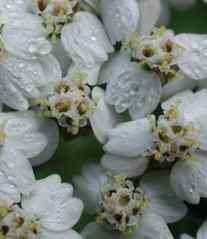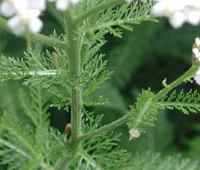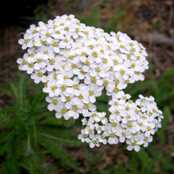Food from Photosynthesis
In contrast to animals, fungi and other heterotrophic organisms that rely on organic materials for nutrition, plants synthesize their own food through the use of inorganic substances. This synthesis is the chemical process of photosynthesis. Photosynthesis, complimented with the uptake of nutrients from the soil makes up the method of food acquisition of Achillea millefolium.


Photosynthesis
Photosynthesis requires light energy, water, and carbon
dioxide to complete the process of converting
sunlight to a usable food source.
Light Energy
The process of photosynthesis takes place in the plant’s
chloroplast, using the pigment chlorophyll to absorb
the energy from the sun. Chloroplast and chlorophyll
are found in all green parts of the plant, for
example, the leaves and stem.
Water Acquisition and Transport
Next, water in the soil is pulled up throughout the
plant via a structure known as xylem. Water begins
its journey by being absorbed through Achillea
millefolium’s horizontal underground fibrous
root system. Water is absorbed by the roots because
of its water potential. Water moves into the cells
of the Yarrow root via osmosis. This is because
there is a higher concentration of solutes inside
the cell, and water always moves from an area of low
concentration to an area of high concentration.
Once the water enters the root cells it moves toward
the xylem through pathways known as the apoplast
which are connections between cell walls, and
pathways known as symplast, connections in the
interior of the cell. After reaching the xylem, the
water continues to the upper parts of the plant due
to transpiration, adhesion, and cohesion.
pathways known as the apoplast
which are connections between cell walls, and
pathways known as symplast, connections in the
interior of the cell. After reaching the xylem, the
water continues to the upper parts of the plant due
to transpiration, adhesion, and cohesion.
As water begins to transpire through the leaves, it
creates a reduced water potential, or increased
solute concentration, of the cells in the leaves.
As previously stated, water will always move from
an area of low concentration to a high
concentration; thus, water molecules will be pulled
along to the regions of high concentration. Adhesion
and cohesion now assist in the pulling up of
additional water molecules. Adhesion gives the polar
water molecules a high affinity for other polar
molecules, for instance, the cellulose of the Yarrow
cell walls. Cohesion is the property that allows
water molecules to stick to one another. As you can
see, all three processes (transpiration, adhesion,
and cohesion) work together to transport water
through Achillea millefolium.
Carbon Dioxide
Finally, Carbon Dioxide is needed to complete
photosynthesis. To allow for the entrance of CO₂,
leaves contain small pores called stomata.
Stomata include two guard cells, and when the guard
cells have adequate water they bow outward causing
an opening for gas exchange (CO₂ entrance).
Sugar Creation and Transport
Although the previous steps are vital in the
process of photosynthesis, the most important factor
is that all of those ingredients combine to create
sugar! These sugars commonly are found as glucose
and sucrose. These sugars act as the primary source
of energy for Achillea millefolium. This
calls for sugar transport to all parts of the plant.

After production, the sugars travel through a cell
via the apoplast or symplast toward the phloem.
Although similar to xylem in its ability to
transport nutrients, phloem transfers nutrients to
all areas in need of nutrition in all directions.
The transport of sugars
and other nutrients begins because of the high
sucrose concentration in the phloem. Then, water
flows in from nearby xylem by osmosis which, in
turn, creates pressure within the phloem. This
pressure build-up causes the concentrated and
pressurized sucrose solution to flow to areas of
lower sucrose concentration (areas in need of
nutrients).
Lastly, in order to keep the flow of sugars and
nutrients going, high concentrations of sugar must
be maintained so that osmosis of water and pressure
build-up continues. In order to add a concentrated
solution (more sugar) to an already concentrated
solution, active transport is necessary. Any excess
of sugars that are not usable at the time of
dispersal are stored as starch.

Here completes the ongoing cycle of nutrient acquisition, transport, and storage for Achillea millefolium. Other species within the Multiple Organisms Web Page such as the Sugar Maple and Tamarack also use photosynthesis as a means of nutrition acquisition. Discover more about these organisms as well!
Back to Adaptation
To explore the reproductive cylce of Yarrow, continue to Reproduction.
